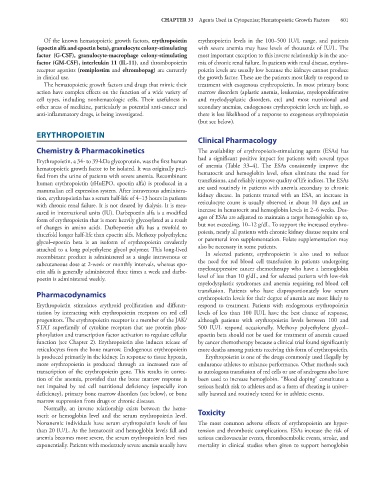Page 615 - Basic _ Clinical Pharmacology ( PDFDrive )
P. 615
CHAPTER 33 Agents Used in Cytopenias; Hematopoietic Growth Factors 601
Of the known hematopoietic growth factors, erythropoietin erythropoietin levels in the 100–500 IU/L range, and patients
(epoetin alfa and epoetin beta), granulocyte colony-stimulating with severe anemia may have levels of thousands of IU/L. The
factor (G-CSF), granulocyte-macrophage colony-stimulating most important exception to this inverse relationship is in the ane-
factor (GM-CSF), interleukin 11 (IL-11), and thrombopoietin mia of chronic renal failure. In patients with renal disease, erythro-
receptor agonists (romiplostim and eltrombopag) are currently poietin levels are usually low because the kidneys cannot produce
in clinical use. the growth factor. These are the patients most likely to respond to
The hematopoietic growth factors and drugs that mimic their treatment with exogenous erythropoietin. In most primary bone
action have complex effects on the function of a wide variety of marrow disorders (aplastic anemia, leukemias, myeloproliferative
cell types, including nonhematologic cells. Their usefulness in and myelodysplastic disorders, etc) and most nutritional and
other areas of medicine, particularly as potential anti-cancer and secondary anemias, endogenous erythropoietin levels are high, so
anti-inflammatory drugs, is being investigated. there is less likelihood of a response to exogenous erythropoietin
(but see below).
ERYTHROPOIETIN
Clinical Pharmacology
Chemistry & Pharmacokinetics The availability of erythropoiesis-stimulating agents (ESAs) has
had a significant positive impact for patients with several types
Erythropoietin, a 34- to 39-kDa glycoprotein, was the first human
hematopoietic growth factor to be isolated. It was originally puri- of anemia (Table 33–4). The ESAs consistently improve the
fied from the urine of patients with severe anemia. Recombinant hematocrit and hemoglobin level, often eliminate the need for
human erythropoietin (rHuEPO, epoetin alfa) is produced in a transfusions, and reliably improve quality of life indices. The ESAs
mammalian cell expression system. After intravenous administra- are used routinely in patients with anemia secondary to chronic
tion, erythropoietin has a serum half-life of 4–13 hours in patients kidney disease. In patients treated with an ESA, an increase in
with chronic renal failure. It is not cleared by dialysis. It is mea- reticulocyte count is usually observed in about 10 days and an
sured in international units (IU). Darbepoetin alfa is a modified increase in hematocrit and hemoglobin levels in 2–6 weeks. Dos-
form of erythropoietin that is more heavily glycosylated as a result ages of ESAs are adjusted to maintain a target hemoglobin up to,
of changes in amino acids. Darbepoetin alfa has a twofold to but not exceeding, 10–12 g/dL. To support the increased erythro-
threefold longer half-life than epoetin alfa. Methoxy polyethylene poiesis, nearly all patients with chronic kidney disease require oral
glycol–epoetin beta is an isoform of erythropoietin covalently or parenteral iron supplementation. Folate supplementation may
attached to a long polyethylene glycol polymer. This long-lived also be necessary in some patients.
recombinant product is administered as a single intravenous or In selected patients, erythropoietin is also used to reduce
subcutaneous dose at 2-week or monthly intervals, whereas epo- the need for red blood cell transfusion in patients undergoing
etin alfa is generally administered three times a week and darbe- myelosuppressive cancer chemotherapy who have a hemoglobin
poetin is administered weekly. level of less than 10 g/dL, and for selected patients with low-risk
myelodysplastic syndromes and anemia requiring red blood cell
Pharmacodynamics transfusion. Patients who have disproportionately low serum
erythropoietin levels for their degree of anemia are most likely to
Erythropoietin stimulates erythroid proliferation and differen- respond to treatment. Patients with endogenous erythropoietin
tiation by interacting with erythropoietin receptors on red cell levels of less than 100 IU/L have the best chance of response,
progenitors. The erythropoietin receptor is a member of the JAK/ although patients with erythropoietin levels between 100 and
STAT superfamily of cytokine receptors that use protein phos- 500 IU/L respond occasionally. Methoxy polyethylene glycol–
phorylation and transcription factor activation to regulate cellular epoetin beta should not be used for treatment of anemia caused
function (see Chapter 2). Erythropoietin also induces release of by cancer chemotherapy because a clinical trial found significantly
reticulocytes from the bone marrow. Endogenous erythropoietin more deaths among patients receiving this form of erythropoietin.
is produced primarily in the kidney. In response to tissue hypoxia, Erythropoietin is one of the drugs commonly used illegally by
more erythropoietin is produced through an increased rate of endurance athletes to enhance performance. Other methods such
transcription of the erythropoietin gene. This results in correc- as autologous transfusion of red cells or use of androgens also have
tion of the anemia, provided that the bone marrow response is been used to increase hemoglobin. “Blood doping” constitutes a
not impaired by red cell nutritional deficiency (especially iron serious health risk to athletes and as a form of cheating is univer-
deficiency), primary bone marrow disorders (see below), or bone sally banned and routinely tested for in athletic events.
marrow suppression from drugs or chronic diseases.
Normally, an inverse relationship exists between the hema-
tocrit or hemoglobin level and the serum erythropoietin level. Toxicity
Nonanemic individuals have serum erythropoietin levels of less The most common adverse effects of erythropoietin are hyper-
than 20 IU/L. As the hematocrit and hemoglobin levels fall and tension and thrombotic complications. ESAs increase the risk of
anemia becomes more severe, the serum erythropoietin level rises serious cardiovascular events, thromboembolic events, stroke, and
exponentially. Patients with moderately severe anemia usually have mortality in clinical studies when given to support hemoglobin

